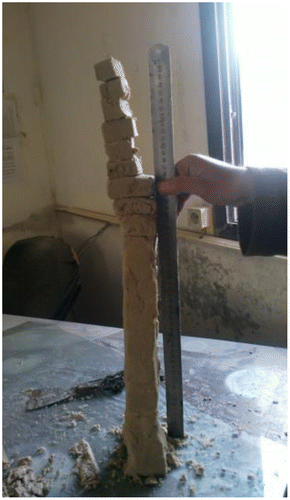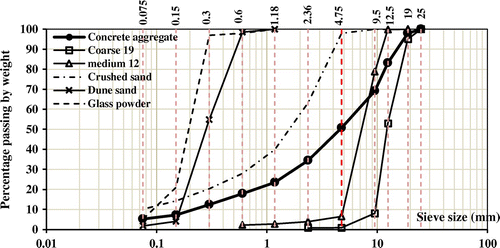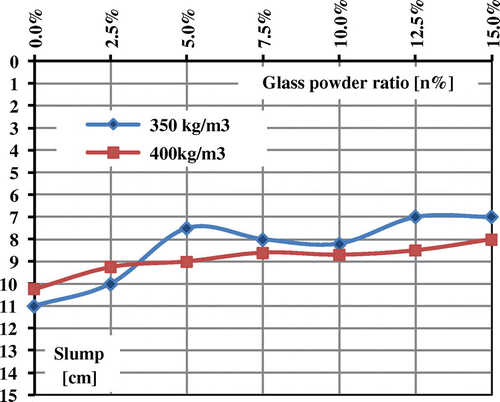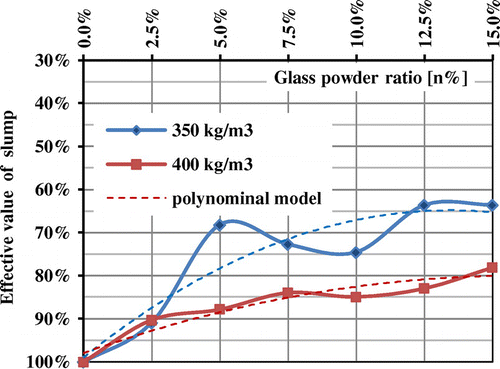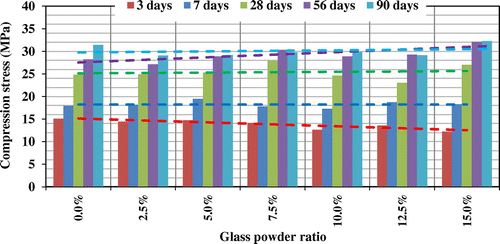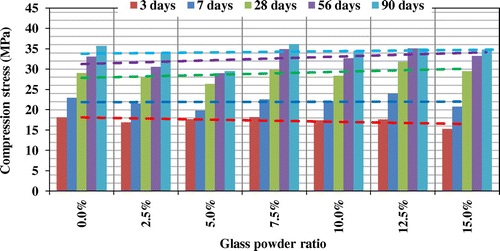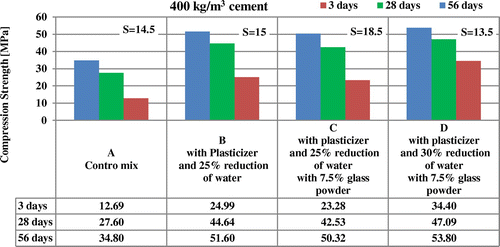Abstract
Several studies have been made to examine the potential mineralogical and mechanical properties of glass aiming to improve the characteristic properties of concrete where glass has been used in various forms, powder form or fine and coarse aggregate form, taken as part of aggregate or replacement of cement. However, the results presented in these studies were sometimes very different, even contradictory, due to the way in which the glass was used in these experiments, leading to a difficulty in distinguishing between the effect of Glass and the role of cement. To overcome this confusion the present research aimed to study the effects of glass powder on the properties of concrete by series of test for two constant quantities of cement, 350 and 400 kg per cubic meter. To reach the target of this research, two campaigns were done. In the first campaign the glass powder is gradually increased from trial to another by an increment of 2.5% of the cement’s weight, from a rate of 2.5 up to 15%, without any chemical additive. This methodology made it possible to show the effect of the glass powder on the characteristic properties of concrete and defined its real contribution without being confused with the role of the cement. In the second campaign the study is extended to add the glass powder by rate of 7.5% to the batches with the use of super-plasticizer type F to investigate its potential mechanical properties. The slump test and compression test showed modest results in the first campaign but very important results in the second, when the glass powder was added with the plasticizer, which could be promoted to serve the concrete industry, particularly the production of the self compacting concrete where high performance concrete is required.
Public Interest Statement
Man, who has taken too much of nature to improve his daily life, now has a duty to protect his mother nature. His life of investigation, exploration and invention is today threatened with environmental damage resulting from his intelligence, his infinite curiosity, his arrogance and his greed; whatever is his knowledge of this reality and his willingness to correct his attitude, he has a huge work to prove his rationality which reflects his respect and fidelity to the equilibrium of nature that has been assaulted for decades.
The contribution of the concrete industry, and its main branch the production of cement, to the diffusion of CO2 gas into the atmosphere is a major problem that needs solutions. Investing the potential properties of waste glass offered previously gratis by nature to reduce the atmospheric damage produced by the cement production is the philosophy of this work carried out sincerely with few tools and resources but with too much enthusiasm.
1. Introduction
Many researchers showed great interest to investigate the effects of waste glass for its appropriate characteristics, in form of powder or fine and coarse aggregates, to improve the properties of fresh and hardened concrete.
The glass leads two types of antagonistic action, the alkaline-silica reaction (ASR), which causes damage in concrete, and its pozzolanic reaction, which is considered beneficial for the properties of concrete (Idir, Cyr, & Tagnit-Hamou, Citation2011).
The alkali-silica reaction is usually associated with coarse particles containing amorphous silica where a destruction of the silica network occurs to release silica that combines with alkali and calcium to form N,K-(C)-S-H gels which is causing expansion of the concrete (Shao, Lefort, Moras, & Rodriguez, Citation2000; Shayan & Xu, Citation2006).
While the pozzolanic activity is usually related to fine particles where the silica is released after the destruction of the silica network by the hydroxide ions, combines with calcium from Portlandite to form C-(N,K)-S-H which improve concrete properties (Carles Gibergues, Cyr, Moisson, & Ringot, Citation2008; Cyr, Rivard, & Labrecque, Citation2009). Pereira de Oliveira, Castro Gomes, and Santos (Citation2012) reported that the glass powders fineness is a fundamental parameter in the glass pozzolan’s production to increase their potential reactivity.
Bhat and Bhavanishankar Rao (Citation2014) concluded that an increase of 27% compressive strength could be achieved when 20% cement was replaced by glass powder in concrete if W/C ratio wasn’t maintained, but the results showed a decrease of compressive strength when W/C ratio was maintained.
Anwar (Citation2016) used the waste glass powder as replacement of cement in the mix proportion; the waste glass powder was varied in fraction from 0 to 50% per increment of 5% by weight of concrete. Concrete was tested on compression, split and flexure strength, and an appreciable increase in strength was observed with the increase in percentage replacement of cement by glass powder from 5 to 15%. The author estimated that the strength increase has taken place after 28 days because of pozzolanic action of glass powder; however, there was no explanation for the considerable decrease of strength from rate 20 to 50%.
Raju and Kumar (Citation2014) have conducted a similar study using the glass powder as replacement of cement in the range of 5 to 40% by increment of 5%. Concrete was tested for compressive strength and flexural strength. The results showed that with the increase of glass powder up to 20% strength increases and beyond that it decreases. They interpreted this improvement by the pozzolanic reaction and the increase of concrete’s density by the filling of powder in void, while authors didn’t give an explanation to results beyond 20% glass powder.
Test also showed a decrease on workability as the glass powder increases, this phenomena was interpreted by the reduction in modulus of cementitious material needed for providing a lubricating effect per unit surface area of aggregate, so they used a super plasticizer to maintain workability with restricted water cement ratio. These results are also not far from those of Jangid and Saoji (Citation2014).
Otherwise, Shekhawat and Aggarwal (Citation2014), Gunalaan and Kanapathy Pillary (Citation2013), found that the workability is reduced with the rate of cement replacement, and explained this reduction by the increase in the surface area of the glass powder and also the angular shape of the glass particles. Contrariwise Keryou and Ibrahim (Citation2016) confirmed a reduction of water requirement as the glass powder content increases and an improvement of compressive strength at the early age followed by a decrease with the age of curing due to the Alkali-Silica Reaction.
Other studies worked on the waste fine and coarse glass particles as part of concrete aggregate to investigate the pozzolanic reaction, concrete density, flexure and split tension, durability, water absorption and sorptivity.
This diversity of results shown for the glass powder doesn’t lead to a clear explanation of the glass effects on the concrete’s behavior. To overcome this diversity and the difficulty of distinguishing between the effect of glass and the role of cement, a methodology was followed in this paper to investigate the underlying properties of glass powder to improve the workability of fresh concrete and its characteristics after hardening for short and long time.
2. Significance of the work
In the face of the environmental and economic obligations imposed in this century, a sincere revision of the methods and materials used in construction has become paramount. In this perspective, the production of cement used in concrete is one of the main problems targeted by the industry and academic research institutes, first to protect the environment from CO2 released in the atmosphere by the intensive production of cement to satisfy the increasing demand of this binder over time, on second hand to improve its properties to better meet the new obligations of quality and performance.
On another stage the glass waste began imposing wide discussions on the feasibility and the efficiency of its recycling because this material is non-degradable and possesses very good physical, mechanical, thermal and mineralogical properties which make it possible to be used in large field of production.
In front of this panoramic view the research institutes implemented projects to make a fusion of view making integrating the work on the particular properties of the glass as waste and the obligations of the cement industry and reciprocally the concrete in order to produce a new cementitious binder that respects the environmental duties and economic concerns of the construction industry.
The way this work is conducted aims to create new scientific additions while taking advantage of all previous research work done.
3. The research processes
To study the effects of glass powder on the properties of concrete, series of test were done the amount of cement was maintained constant and the glass powder was taken by ratio of cement. This approach aimed to distinguish between the role of the cement and that of the glass powder.
Two campaigns were made, for 350 and 400 kg amount of cement. In the first campaign the glass powder was added by an increment of 2.5% of the cement weight progressively up to a maximum rate of 15%, without any chemical additive. In the second the trials were made only for rate of 7.5% glass powder by adding chemical additive to the batches.
In all cases of test the weight of aggregate was adjusted respectively with the increase of the glass powder in the batch. Table shows in details the weight and volume of glass powder for different concrete batch where it should be noted that the decrease of aggregate’ volume in concrete batch did not exceed the rate of 2.4% in the maximum case of 15% glass powder for 400 kg cement which could be insignificant.
Table 1. Rate of glass powder by volume and weight to the concrete batches
To calibrate the effect of the glass powder and to develop a wide perception about this fine particles on the concrete behavior at early and advanced age, the concrete mixture with glass powder was tested, analyzed and compared with that of “control mixture” free of glass powder.
4. Materials and laboratory tests
4.1. Glass powder
This glass powder was prepared from transparent glass waste. It was grounded and then passed through the sieve of 0.6 mm (N°30) where more than 95% passed through the sieve of 0.25 mm (N°60). The physical and mechanical tests gave a value of 2,500 kg/m3 of specific density and 2,850 cm2/g for the specific surface area; the value of the dry internal angle was varied between 24° and 26° and 18° to 20° for the saturated friction angle. The chemical composition analysis gave a value of 65% by weight of SiO2 and 15% for the sum of CaO and Na2O.
An additional test showed a zero value for the absorption rate, and a strong capillary action, which helped to build a column of 60 cm for a section of 3 × 3 cm, as shown in Figure .
4.2. Physical and mechanical properties of aggregates
Four granular materials are used to form the concrete aggregates: coarse aggregate (19 mm), medium aggregate (12.5 mm), crushed sand (4.75 mm) and natural fine sand (1 mm) which is used usually in the country. Table shows the physical and mechanical test results for these 4 materials.
Table 2. Physical and mechanical properties of aggregates
4.3. Concrete mix design
The proportion of aggregates was adjusted by the inverse regression method, using an optimization program (Rahma, Citation2013) where an optimal curve was used; the curve has the form p% = a.db, with 6% (# 200) of fines particles and the percentage of Sand/Coarse = 1; where “d” is the nominal diameter of concrete aggregate; “a” and “b” are constant; Figure shows the aggregates’ distribution curves.
For best modeling of glass powder effect, the 2 control mixtures of concrete were prepared without glass powder for 350 and 400 kg/m3 cement. The needed water and the consistency of the control mixtures were controlled by Abram’s method, and the slump was adjusted to 11 cm for 350 kg/cm3 and 10.5 cm for 400 kg/m3 (Table ).
Table 3. Control mixtures’ information’s
4.4. Sampling
For the first campaign, including the control mix, 14 concrete batches were prepared and 15 cubic samples of 15 cm were taken for each batch, in total 210 samples. For the second campaign, in total 8 batches were prepared and 9 cubic sample were taken for each batches, in total 72 samples.
The samples were cured for 24 h then conserved in the water with a temperature of 23 ± 2C° according to ASTM-192 recommendation (ASTM C 192/C 192M, Citation1994).
The cubic compression strength was defined by uniaxial compression test per set of 3 samples respectively at ages of 3, 7, 28, 56, 90 days. Figures and show the average strength value (cylindrical value) where a factor of 0.8 is used.
5. Test results and discussion
5.1. Effect of glass powder on the consistency
In the series of tests without any chemical material, the slump was measured for each rate of glass powder. Figure shows the recorded value of each case; Figure gives the percent value of the slump relative to that of the control mixture for 350 and 400 kg cement.
As shown in Figures and , the results mark clearly a considerable decrease of consistency where increasing the glass powder in the mixture results in a significant decrease of concrete workability; this loss of consistency depends on the rate of glass powder and conversely with the cement content where the loss of slump, in the case of 15% of glass powder, reaches 35% for 350 kg cement and 22% for 400 kg cement.
The decrease of workability could be interpreted due to the high surface tension of glass powder, justified by the strong capillary action shown in Figure ; while the quantity of cement plays a reverse role, due to the amount of paste in the batches, which increases the constancy of concrete by its gelatinous property.
5.2. Effect of glass powder on compression strength
Looking at the results of the simple compression test, in the Figures and , for the cases of 350 and 400 kg cement, there was a decrease of strength for the age of 3 days relatively to the control mixtures. However, there was slight increase of strength for the ages of 28, 56 and 90 days.
This improvement of concrete strength reached at the age of 56 days a value of 8% for 350 kg cement with 15% glass powder and 12% for 400 kg cement with 12.5% glass powder.
The results show a clear decrease of strength at the early days of hardening in the case of 350 and 400 kg cement; this decrease of strength was affected by the rate of glass powder. However, this decline was followed by a slight improvement of strength in the following days and gets better in the advanced ages of 28 and 56 days.
This decline of strength denies any pozzolanic reaction of the glass powder even in the long time. Whereas the slight improvement of strength could be interpreted by a slow recovery of water retained at the beginning before hardening, due to the high surface tension related to the finesses and the high surface area of the powder, which returns in the advanced ages to contribute again to the hydration process of cement.
This modest contribution of glass powder is justified at the different ages for the two cement contents 350 and 400 kg cement.
5.3. Associated effect of glass powder with chemical additives
For the second campaign of tests a water reducer type F (ASTM C 494/C 494M, Citation1994) was added to the concrete mixtures with 7.5% rate of glass powder. The recommended dose of the water reducer is 1.2 l/100 kg cement, 80% of this value was used to get a better margin of manipulation.
In the first step the required amount of water of the control mixtures (for 350 and 400 kg cement) was recalibrated for an initial slump that varied between 14 and 15 cm, depending on the cement content. This procedure is taken to give the concrete an adequate consistency to better investigate the effect of glass powder with chemical additives.
4 trials were performed, and each mixture was respectively considered as a reference for the next test:
| • | Mixture (A): The control mix, the required water was adjusted for 14.5 cm slump, without glass powder. | ||||
| • | Mixture (B): mixture A with 0.96 l of water reducer per 100 kg cement (80% of the recommended dose) and 25% reduction of required water without glass powder. | ||||
| • | Mixture (C): mixture B with 7.5% glass powder. | ||||
| • | Mixture (D): mixture C with reduction of required water from 25 to 30%. | ||||
Figures and show the values of the corresponding slump and the uniaxial compression strength for all mixtures.
The results show a significant role played by the glass powder. The results could be summarized from step to step by the following:
| • | Steps A & B: The mixture B shows the expected role of the water reducer. For 25% decrease of required water the water reducer recovered the slump stated in A and improved the compressive strength. At 56 days age the concrete gained approximately 50% of compressive strength for 350 and 400 kg cement. | ||||
| • | Steps B & C: By adding an amount of 7.5% of glass powder to mixture B, there was a high increase of workability for mixture C and a significant increase of slump (20 cm in the case of 350 kg cement and 18.5 cm for the case of 400 kg cement) with increase of strength in order of 11% for 350 kg cement but an unexpected slight decrease of strength for 400 kg cement, by rate of 7% at 3 days which improved gradually with time to 5% for 28 days and 2% only for 56 days, this loss of strength due probably to the sampling and curing of concrete. This improvement is explained, on one hand, by the loss of the surface tension efficiency of the glass powder due to the oily characteristics of the water reducer and on the other hand the transformation of the glass powder to lubricating material, due to its zero absorption, its finesses and the low friction angle (18°–20° for saturated particles). | ||||
| • | Steps C & D: The required water stated in C decreased from 25% to 30% where consequently an increase of strength produced for 350 and 400 kg cement, with the expected decrease of slump to reach approximately the value of slump design. | ||||
The trials manipulation showed a considerable contribution of the glass powder to the appropriate function of the water reducer where the glass powder has allowed a further decrease in the required water consequently reaching a high increase of strength while maintaining the given slump.
6. Conclusions
| • | The results prove the ability and the importance of working on fixed quantities of cement in the testing process to discriminate the effective role of the glass powder from that of cement. | ||||
| • | For normal concrete without plasticizer, the workability decreases when the rate of glass powder increases, despite its zero absorption; this phenomenon could be explained by the effect of the high surface tension (Figure ), developed by the finesses and high surface area of this powder, which captures a required amount of water for consistency. The reserved amount of water recovers simultaneously with the development of the hydration over time and leads to increase modestly the strength of concrete. | ||||
| • | In the case of using the glass powder with the water reducer, the trial results showed a significant role played by the glass powder, where an associated mechanism between the glass powder and the plasticizer acts and allows to reduce the amount of water, therefore increasing the strength of concrete simultaneously with an improvement of workability. | ||||
Cover image
Source: Authors
Acknowledgements
This study was carried out as a research project at Damascus University (Syria) for which we show all sincere gratitude and appreciation.
Additional information
Funding
Notes on contributors
Afif Rahma
The behavior of the granular medium was the principal axis of my researches where the statistical modeling took part. This work is developed to look at the effect of high stresses on the physical and mechanical properties of grains, consequently the mechanical properties of the granular medium on the microscopic and macroscopic scale.
The research is then oriented towards concrete, where cement intervenes as fine cementitious material, to act and influence the behavior of the fresh and hardened granular medium. The work has taken the way of developing the concrete mix design, the materials and the proportioning, for the profit of some ready mixed concrete companies, to meet the obligations of workability and strength, by the way the economic aspect.
The research in this field was developed to examine the effects of the glass powder and pozzolana on the characteristic properties of concrete, where this article presents part of results related to the glass powder which could be benefic for the concrete industry.
References
- Anwar, A. (2016). The influence of wast glass powder as pozzolanic material in concrete. International Journal of Civil Engineering and Technology (IJCIET), 7, 131–148.
- ASTM C 192/C 192M. (1994). Standard practice for making and curing concrete test specimens in the laboratory. West Conshohocken, PA: American Society for Testing and Materials.
- ASTM C 494/C 494M. (1994). Standard specification for chemical admixture for concrete Test Specimens in the Laboratory. West Conshohocken, PA: American Society for Testing and Materials.
- Bhat, V. V., & Bhavanishankar Rao, N. (2014). Influence of glass powder on the properties of concrete. International Journal of Engineering Trends and Technology, 16, 196–199.10.14445/22315381/IJETT-V16P242
- Carles Gibergues, A., Cyr, M., Moisson, M., & Ringot, E. (2008). A simple way to mitigate alkali-silica reaction. Materials and Structures, 40, 73–83.
- Cyr, M., Rivard, P., & Labrecque, F. (2009). Reduction of ASR-expansion using powders ground from various sources of reactive aggregates. Cement and Concrete Composites, 31, 438–446.10.1016/j.cemconcomp.2009.04.013
- Gunalaan, V., & Kanapathy Pillary S. G. (2013). Performance of using waste glass powder in concrete as replacement of cement. American Journal of Engineering Research (AJER), 2, 175–181.
- Idir, R., Cyr, M., & Tagnit-Hamou, A. (2011). Potential pozzolanicity of glass cullet fines and aggregates. Paris: Annales du Bâtiment et des Travaux Publics.
- Jangid, J. B., & Saoji, A. C. (2014). Experimental investigation of waste glass powder as the partial replacement of cement in concrete production. International Conference on Advances in Engineering & Technology, 55–60.
- Keryou, A. B., & Ibrahim, G. J. (2016). Effect of using windows waste glass as coarse aggregate on some properties of concrete. Engineering and Technical Journal, 32, 1519–1529.
- Pereira de Oliveira, L. A., Castro Gomes, J. P., & Santos, P. (2012). The potential pozzolanic activity of glass and red-clay ceramic waste as cement mortars components. Construction and Building Materials, 31, 197–203.10.1016/j.conbuildmat.2011.12.110
- Rahma, A. (2013). Concrete mix design method, according to a referential structure and the aggregates specific surface area. Journal of Engineering Science, Damascus University, 29, 15–25.
- Raju, S., & Kumar, P. R. (2014). Effect of using glass powder in concrete. International Journal of Innovative Research in Science, Engineering and Technology, 31, 21–427.
- Shao, Y., Lefort, T., Moras, S., & Rodriguez, D. (2000). Studies on concrete containing ground waste glass. Cement and Concrete Research, 30, 91–100.10.1016/S0008-8846(99)00213-6
- Shayan, A., & Xu, A. (2006). Performance of glass powder as a pozzolanic material in concrete: A field trial on concrete slabs. Cement Concrete Research, 36, 457–468.10.1016/j.cemconres.2005.12.012
- Shekhawat, Bh S, & Aggarwal, V. (2014). Utilisation of waste glass powder in concrete– A Literature Review. International Journal of Innovative Research in Science, Engineering and Technology, 3, 14822–14826.

